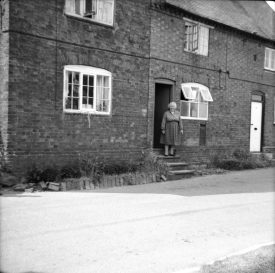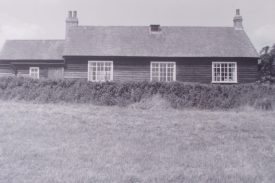The village had little in the way of amenities. There was a post office but no village shop. There had been one operated out of a hut in a garden but it had closed sometime around 1950. If you wanted cigarettes, tobacco, sweets, pop or paraffin oil – very important until people acquired electric cookers – you went to Lottie’s or, as she was known more formally, Mrs (Charlotte) Williams. She operated this modest business out of her house. So for the most part you did your shopping in Warwick and Leamington, and this again underlined the importance of the bus service. Likewise there was no pub. There was, however, a working man’s club, which functioned very much as a pub but without the latter’s modest comforts.On the other hand, and in contrast to this absence of amenities, there was a blacksmith’s. Located opposite the school it was an attraction for the children. They would stand in the open doorway on their way home from school and see the blacksmith tending the forge, sparks coming from the furnace, hammering out horseshoes or, if you were lucky, seeing a horse shod. But horses were rapidly being replaced by tractors, and the blacksmith was disappearing with them. The local blacksmith tried to fight change by branching out into replacing the springs of cars, but it was a losing battle and by 1950 it was no more.
The air of a farming village
Despite the agricultural mechanisation and the fact that so many of the villagers earned their livelihood elsewhere, Hampton on the Hill still had the air of a farming village. Cows would be driven along the roads to pasture leaving the occasional cow pat on the road. You could still see carts pulled by horses moving along the roads, carts loaded with cow muck to be spread on the fields. Farm workers were a clearly recognisable social grouping in the village since the occupations of everyone else were so diverse: laundry worker, machinist, clerk in the county offices, assembly line worker, and so on.
Another reminder of the agricultural character of the village, even while it was dwindling, was the fact that the fox hunt would also meet occasionally at the village prior to forays into the surrounding farm land: the unspeakable in pursuit of the uneatable as sceptics and animal lovers would describe it. The hunt was a major feature in the lives of some local farmers and certainly of the landowners.
No street lights
In the immediate postwar period, there was no electricity, no street lights. People used paraffin lamps as a source of illumination. Electricity probably arrived just shortly after the war and street lights in the early ’50s. Running water did not arrive till sometime in the mid-’50s; until then my father brought it by bucket from the pump in the backyard of a neighbour. Water for baths – and they were of necessity quite infrequent – came from a tank or water butt outside that collected rainwater off the roof of the house. It then had to be heated on the paraffin stove; quite primitive, in other words. Needless to say, mains sewage did not exist and even as late as the mid-’60s people used buckets and disposed of the contents by digging them into the garden – how the vegetables must have loved it!
The roads were largely gravel on tar. Most people had a bike and used it. There were still few cars on the roads so one never felt threatened. A lovely surprise in the spring or early summer, cycling home from school in Warwick in the 1950s, would be to come across the road menders putting down a new layer of gravel, complete with a literally steam-driven steam roller: ‘lovely’ because of the smell of the warm tar, though perhaps not so lovely for those who had to work with it.










Comments
Add a comment about this page